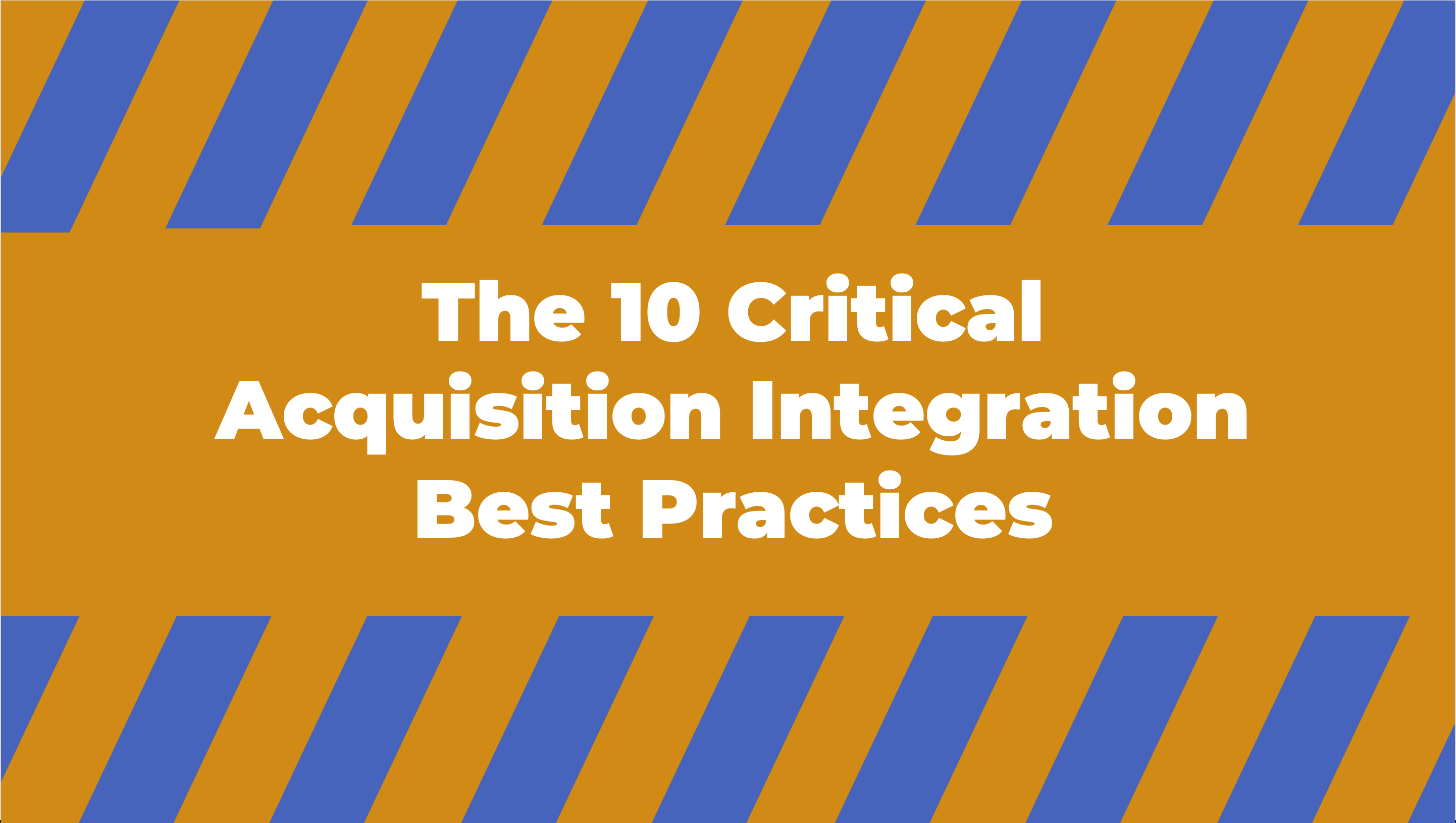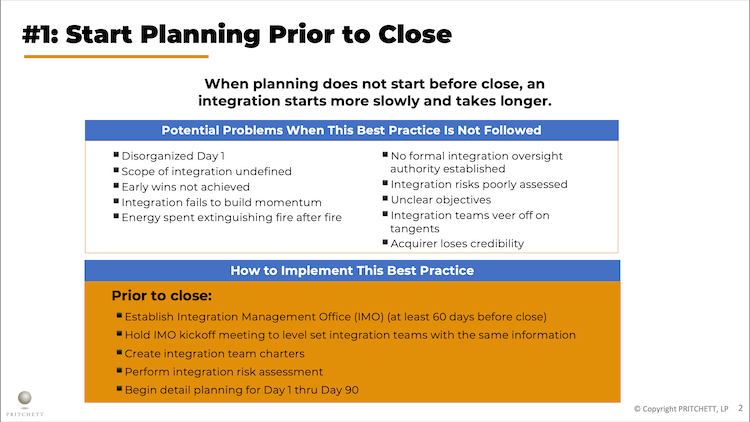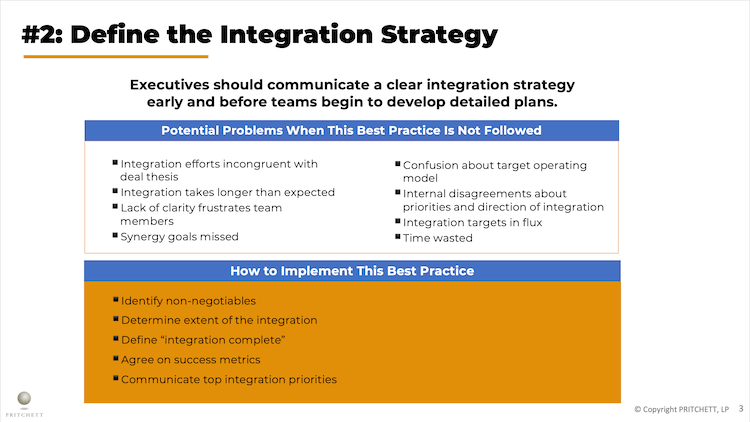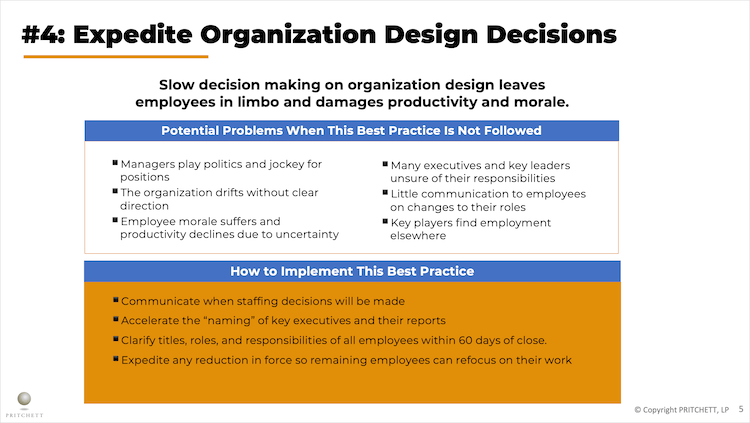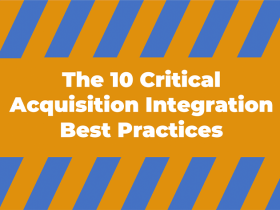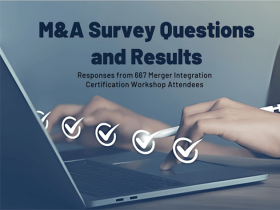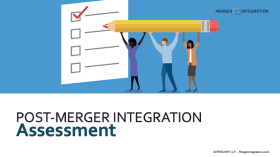-
Start Planning Prior to Close
When planning does not start before close, an integration starts more slowly and takes longer.
Potential Problems When This Best Practice Is Not Followed
- Disorganized Day 1
- Scope of integration undefined
- Early wins not achieved
- Integration fails to build momentum
- Energy spent extinguishing fire after fire
- No formal integration oversight authority established
- Integration risks poorly assessed
- Unclear objectives
- Integration teams veer off on tangents
- Acquirer loses credibility
How to Implement This Best Practice
Prior to close:
- Establish Integration Management Office (IMO) (at least 60 days before close)
- Hold IMO kickoff meeting to level set integration teams with the same information
- Create integration team charters
- Perform integration risk assessment
- Begin detail planning for Day 1 thru Day 90
-
Define the Integration Strategy
Executives should communicate a clear integration strategy early and before teams begin to develop detailed plans.
Potential Problems When This Best Practice Is Not Followed
- Integration efforts incongruent with deal thesis
- Integration takes longer than expected
- Lack of clarity frustrates team members
- Synergy goals missed
- Confusion about target operating model
- Internal disagreements about priorities and direction of integration
- Integration targets in flux
- Time wasted
How to Implement This Best Practice
- Identify non-negotiables
- Determine extent of the integration
- Define “integration complete”
- Agree on success metrics
- Communicate top integration priorities
-
Maintain the Focus on Priorities
Without effective prioritization, high-payback activities receive too little attention.
Potential Problems When This Best Practice Is Not Followed
- Low-value work absorbs attention
- Synergies not pursued aggressively
- Tremendous effort expended to make little progress
- Morale of integration teams declines
- Integration workload overwhelming
- Resources wasted
- Decisions made slowly
- High-priority work pushed aside
How to Implement This Best Practice
- Communicate integration objectives including synergy targets
- Create integration prioritization framework for use by functional leads
- Allocate adequate resources to the “must haves”
- Assign major synergies to initiatives and treat those initiatives as priorities
- Focus IMO’s reporting on high-priority milestones
-
Expedite Organization Design Decisions
Slow decision making on organization design leaves employees in limbo and damages productivity and morale.
Potential Problems When This Best Practice Is Not Followed
- Managers play politics and jockey for positions
- The organization drifts without clear direction
- Employee morale suffers and productivity declines due to uncertainty
- Many executives and key leaders unsure of their responsibilities
- Little communication to employees on changes to their roles
- Key players find employment elsewhere
How to Implement This Best Practice
- Communicate when staffing decisions will be made
- Accelerate the “naming” of key executives and their reports
- Clarify titles, roles, and responsibilities of all employees within 60 days of close.
- Expedite any reduction in force so remaining employees can refocus on their work
-
Deliver Frequent and Clear Communications
Communication is usually the worst managed aspect of integrations. People are often left out of the loop or receive mixed messages.
Potential Problems When This Best Practice Is Not Followed
- Uncertainty harms employee morale and productivity
- Rumor mill runs wild
- Leadership perceived to be uncaring and out of touch
- “A” players jump ship
- Communications reactive, not proactive
- Little work to determine high-priority communication needs
- Information sharing on an “as needed basis”
- No process for answering questions
How to Implement This Best Practice
- Craft key messages for each key stakeholder audience
- Create communication plan matrix prior to close for Day 1 thru Day 90
- Script early communications so managers do not improvise, unintentionally fuel speculation, and create unnecessary angst
- Communicate frequently through multiple channels
- Create “rolling FAQ log,” update weekly, and share with employees
The 10 Critical Acquisition Integration Best Practices
Merger Integration Certification Workshop attendees and MergerIntegration.com subscribers can download the complete file in PowerPoint (not PDF format) that includes the additional slides.
Download Above PDF
